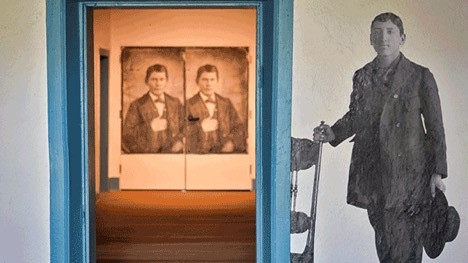Indigenous Enslavement in Southern Colorado installation opens

FORT GARLAND — A new installation by artist jetsonorama is now on view at History Colorado’s Fort Garland Museum and Cultural Center in the San Luis Valley. Unsilenced: Indigenous Enslavement in Southern Colorado incorporates historic photos of Indigenous captives and images from an 1865 census of enslaved Indigenous people in present-day Conejos and Costilla Counties. On display in one of the fort’s original adobe buildings constructed in 1858, Unsilenced is organized by jetsonorama and Eric Carpio, Director of Fort Garland Museum & Cultural Center and Chief Community Museum Officer for History Colorado.
“Opening Unsilenced is an important step in telling the stories of the individuals and descendants who’ve endured the consequences of this tragic history,” said Carpio. “Our hope is that we can build on this project to deepen our understanding of Indigenous enslavement and serve as a resource for others.”
Prior to the installation, History Colorado hosted a series of virtual Family Memory Workshops during the spring to engage descendants, community members, genealogists, and others in conversations about the impact of this complex and nuanced history. Participants from throughout Colorado and New Mexico participated in the workshops to share personal stories, ask questions, and offer guidance and support to others pursuing their own research.
“As an African-American who has worked in Dinétah for the past 34 years, diving into the history of Native enslavement has been an opportunity to connect historical events previously obscured,” said jetsonorama. “Learning the story of Lafayette Head, seeing the remains of his 1850s home in Conejos County—and the quarters for his family’s enslaved people—resonated deeply, having just completed two plantation tours in South Carolina.”
No closing date has been set for the long-term installation, which is a new element of History Colorado’s ongoing Borderlands of Southern Colorado initiative. Rich in oral histories and other first-person accounts, the Borderlands project centers Chicano, Indigenous, and Mestizo perspectives within its speaker series, memory projects, and additional exhibits at History Colorado museums in Pueblo, Trinidad, and Denver. History Colorado and M12 Studio commissioned Unsilenced to help reflect and support a process of community learning from descendants of Indigenous captives among its staff members and the people and communities they serve. Descendants and community members who would like to participate in upcoming workshops for sharing personal histories are invited to contact Eric at the Fort Garland Museum and Cultural Center at [email protected].
Visitor hours, ticket pricing ($0–5), and more information is available at h-co.org/FortGarland.
Sponsors And Acknowledgements
Unsilenced is supported in part by M12 Studio as part of their Landlines initiative. “Thank you to Estevan Rael-Galvez and Ronald Rael who, two years ago, made the work of Andrés Reséndez’s The Other Slavery palpable for me,” said jetsonorama. “Thank you Drew Ludwig, Esther Belin, Eric Carpio, Dawn DiPrince, the Fort Garland Museum staff, Richard Saxton, and the good people of M12 for helping to make this work possible. A special thank you goes to my indefatigable seamstress Delia Charley who completed this project flawlessly and in record time. It takes a village to prevent truth decay.”
About jetsonorama
Chip Thomas, aka “jetsonorama,” is a photographer, public artist, activist, and physician who has been working between Monument Valley and The Grand Canyon on the Navajo Nation since 1987. There, he coordinates the Painted Desert Project—a community building project which manifests as a constellation of murals across the Navajo Nation painted by artists from all over the reservation and the world. These murals aim to reflect love and appreciation of the rich history shared by the Navajo people back to Navajo people.
As a member of the Justseeds Artists Cooperative, jetsonorama appreciates the opportunity to be part of a community of like-minded, socially engaged artists. You can find his large-scale photographs pasted on the roadside, on the sides of houses in the northern Arizona desert, on the graphics of the People’s Climate March, Justseeds, and 350.org carbon emissions campaign material.
Thomas was a 2018 recipient of a Kindle Project gift and in 2020 he was one of a handful of artists chosen to recognize the 75th Anniversary of the United Nations’ founding.
About the Fort Garland Museum and Cultural Center
Fort Garland was built in 1858, ten years after the Treaty of Guadalupe-Hidalgo, during the United States’ expansion into the west. Today, visitors can explore the culture of the San Luis Valley and life in a nineteenth-century military fort by walking the parade grounds and touring five of the original adobe buildings. The Fort Garland Museum and Cultural Center is a museum of History Colorado.
Fort Garland currently offers Hands-On History Summer Camp for elementary & middle school children. Automatic tuition assistance is available and no family will be turned away based on an inability to pay. Details and registration is available at h-co.org/HOHFtGarland.



